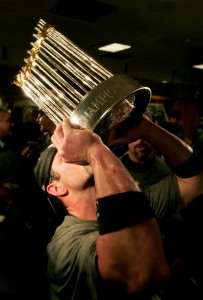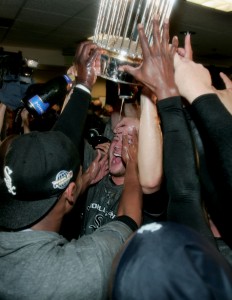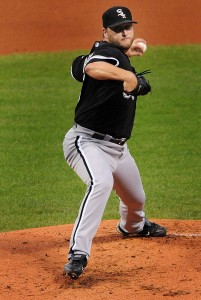The 2005 Chicago White Sox get a bum deal as far as legacies are concerned. When they ended their 87-year championship drought by sweeping the Astros, they did so on the heels of the Red Sox breaking their own curse in dramatic fashion just a year before. Not only were the ChiSox overshadowed preemptively by Boston, but their victory left the crosstown Cubs with the lone multi-generational curse, which instantly drew more attention than even the Sox’ victory. Needless to say, Southsiders have long had a much-deserved chip on their shoulder as the less-heralded of the two Chicago baseball clubs.
The 2005 White Sox deserved more attention than they got, but not just because of their own broken curse. Ozzie Guillen’s club accomplished an amazing feat just in getting to the World Series, one that we may never see again. After dropping game one of the ALCS to Vlad Guerrero Sr. and the Los Angeles Angels of Anaheim, the White Sox won the American League pennant behind four consecutive complete games.
There were zero complete games thrown in the 2019 playoffs. Not a one. There weren’t any in 2018 either. We got one in 2017 (Justin Verlander) and 3 in 2016 (though two of those were in losses where the starter only went 8 innings to get the CG). Not only did the 2005 White Sox rattle off eight straight wins to clinch the World Series, but after taking that game 1 loss (their only loss of the postseason), they strung together four straight complete games from this unlikely quartet: Mark Buehrle, Jon Garland, Freddy Garcia, and Jose Contreras.
It’s not impossible that we’ll see this kind of feat again. I mean, hey, Deacon Phillippe threw five complete games in a single postseason. For the 1903 Pittsburgh Pirates. But as far as this century is concerned, Ozzie Guillen’s likely to hold the record for fewest pitching changes in a postseason series.
Speaking of Guillen, you gotta give the guy props for the trust he had in his starting staff. Not only did he ride his starters for all four wins, but not a one of them put up a shutout. There were trials. There were tribulations. But either Guillen forgot the extension for the bullpen phone, or he believed in his horses. It’s not as if this was all that long ago and complete games were a dime a dozen. The four thrown by the White Sox in the ALCS were the only complete games thrown that postseason. There was just one complete game thrown in the playoffs the year before and none the year after. This was a feat. If it were the Red Sox or the Cubs, we’d probably talk about it a lot more.
So let’s take a moment to appreciate the run.
In terms of all-time rotations, Buehrle/Garland/Garcia/Contreras wasn’t exactly Maddux/Glavine/Smoltz/Avery. But it was a solid group who put together a remarkable run. These four starters not only came together at the perfect time, but at the perfect time in their individual careers.
Buehrle had the best career of the four as the long-time ace of the Southsiders, but his chief abilities included otherworldly defense and durability. The soft-tossing lefty led the AL in innings pitched in both 2004 and 2005. He put up 200-inning seasons for 14 consecutive years, falling short of the line only twice: his rookie season when he made just 3 starts and totaled 51 1/3 innings, and his final season in the majors, when at age 36 he put up “just” 198 2/3 innings for the Blue Jays (while still leading the majors with four complete games). Buehrle only once cracked the top-5 in Cy Young voting, but he was the definition of a reliable workhorse, and in limiting the Angels to just 5 hits and no walks over a tidy 99 pitches, he set the tone for the 2005 White Sox. The Sox won game 2 behind Buehrle 2-1, and they wouldn’t look back.
Jon Garland struggled to stay healthy for much of his career, but he was peaking in 2005. The 25-year-old, hulking right-hander won 18 games that season with a 3.50 ERA, earning his lone All-Star appearance. He threw three complete game shutouts that season, but the amazing piece for Garland was that his game 3 complete game was his first-ever postseason appearance. Not only that, but he’d only have one more, as the game 3 starter in Houston for the World Series. Garland made the most of it, giving up 2 runs on 4 hits while striking out 7. Paul Konerko capped off a three-run first inning with a two-run shot off John Lackey, and Garland took them the rest of the way, using 118 pitches to finish off a 5-2 victory and put the White Sox up 2-1. Garland would give the White Sox two more solid seasons in the rotation before they traded him to the Angels following 2007 for Orlando Cabrera. His run with the White Sox, particularly 2005, would easily go down as the highlight of Garland’s playing days.
The White Sox turned to Freddy Garcia in game 4, but they used the same script from the prior night. Konerko hit a 3-run homer off Ervin Santana in the first and the White Sox never trailed. Garcia had failed to capitalize on the tremendous potential he showed as a 24-year-old for the 2001 Mariners, and by 2005 his best years were already behind him. Still, the White Sox acquired him midseason the year before along with another one-time heralded prospect in Ben Davis for a package of Mike Morse, Miguel Olivo and Jeremy Reed. Garcia put up 3.9 bWAR in his first full season in Chicago, going 14-8 with a 3.87 ERA/4.06 FIP. He threw 228 innings in total, and it was probably his best season outside of Seattle.
His game 4 performance put the White Sox on the brink of the pennant, using 116 pitches while giving up 2 runs, 5 hits, and 1 walk. The Sox tacked on solo runs in each of the third, fourth, and fifth innings, and the Angels never came closer than in the bottom of the second when Garcia surrendered a walk and made an error on an infield single. But with the tying run on first and runners on the corners, Garcia coaxed a double play off the bat of Steve Finley to end the threat. Garcia went the distance and the White Sox won 8-2.
After three straight complete games to put the White Sox up on the Angels 3-1, what really was Jose Contreras to do but go out and do the same? Like Garland, 2005 and 2006 was the pinnacle of Contreras’ stateside career. The Cuban import made his MLB debut as a 31-year-old with the Yankees in 2003, but they shipped him to the White Sox after 18 disappointing starts in 2004 for Esteban Loaiza. In 2005, the 33-year-old Contreras finally posted the type of season that was expected of him after coming over from Cuba. He went 15-7 with a 3.61 ERA/4.21 FIP, good for 3.6 bWAR (second only to the 3.8 bWAR he’d put up the following season).
In many ways, Contreras was the perfect guy to wrap up this incredible run. These outings weren’t the high velocity, high spin types of outings of the current era. Contreras, like the others before him, simply put the ball over the plate and let his defense do the work. He finished with 114 pitches, 3 earned runs, 5 hits, 2 walks, and just 2 strikeouts. Only twice did he allow more than one baserunner in an inning, and 5 times he put together 1-2-3 innings (including the final 4 frames). The White Sox trailed 3-2 entering the 7th inning, but they’d tie it with a Joe Crede solo shot, then take the lead in the 8th when the Angels defense got sloppy. As for Contreras, after giving up the lead with those two runs in the sixth, he wouldn’t allow a baserunner the rest of the way.
The White Sox had some cushion in games 2-4, but there may have been cause for Guillen to let his starters go long. Dustin Hermanson (yes, Dustin Hermanson) saved 34 games for Chicago that year, but he was out of the role by the playoffs and would make just 6 more appearances in the majors. Bobby Jenks had taken over as closer in the playoffs, but he had just 6 saves and 32 appearances under his belt. Maybe Ozzie Guillen didn’t trust his bullpen, but either way, when Konerko and Aaron Roward each doubled home a run in the ninth, Guillen went back to Contreras to finish out the 6-3 victory and secure the White Sox’ first pennant since 1959. Amazingly, Guillen didn’t even have to lift a finger to do it.


